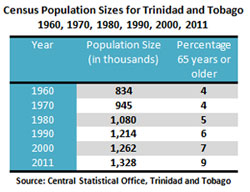
Our population dynamics
 Did you know that it is quite likely that Trinidad and Tobago may never have a population size of 1.4 million persons? Or that the size of the population of Trinidad and Tobago may peak in the mid-2020s and begin declining before 2030? Did you know that it is quite likely that Trinidad and Tobago may never have a population size of 1.4 million persons? Or that the size of the population of Trinidad and Tobago may peak in the mid-2020s and begin declining before 2030?
In 2000, the national census revealed that the size of the population of Trinidad and Tobago was in the vicinity of 1.26 million with 7% of the population being 65 years or older. Today, the population size of Trinidad and Tobago is in the vicinity of 1.36 million with 9% being 65 years or older. By 2055, population size will have declined and is projected to be in the vicinity of 1.26 million but with 23% aged 65 years or older.
Our population dynamics will continue to spring surprises on us, yet we continue to ignore such dynamics. Interestingly, the invisible hand of such dynamics may either result in our children and grandchildren praising us or blaming us.
In Trinidad and Tobago, there has been very little if any reverence for demographic and population-related data that meet the full needs of professionals in the area. Yet key decision-makers including some members of the technocratic arm of the public sector and even politicians, give little or no priority to the development of such statistics, rendering human processes vulnerable in the face of growing social problems. In essence, these statistics constitute the only hope towards validly approximating the facts associated with such problems if they are to be remedied.
In January 2016, the Sir Arthur Lewis Institute of Social and Economic Studies (SALISES) will hosting a conference, “Population Issues and Dynamics in Trinidad and Tobago: Theory, Practice and Policy for Post 2015 SDGs.”
The organizing group, the Caribbean Research Cluster for Population and Sustainable Development, is one of several research clusters associated with the Fifty-Fifty Research Initiative that was established in SALISES in 2012.
This will be the first of a series of country conferences to be organized by the Cluster and it seeks to explore a wide array of population issues that have affected development prospects in Trinidad and Tobago. Subsequent conferences will embrace a similar model focusing on jurisdictions, specifically independent and non-independent states mainly in the Anglophone Caribbean.
It targets the public sector, private enterprise, non-government organizations, community-based organizations, faith-based organizations, grass-roots organizations and especially students pursuing CAPE studies and further tertiary level education.
Rarely, if ever, do local career guidance seminars feature professions such as “statistician,” “demographer,” “research scientist” or “development policy analyst” as alternative professional career options for young persons. CAPE graduates will be exposed to the activities and potential contributions of such professionals and as such, consider such options among their wide array of career choices.
The three-day conference is scheduled for January 7-9, 2016 at the Learning Resource Centre, The UWI, St. Augustine.
(Godfrey St Bernard)
|





